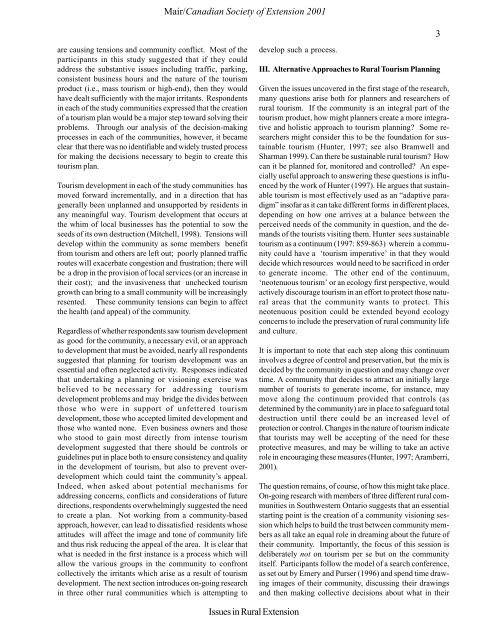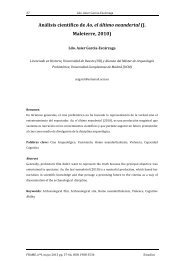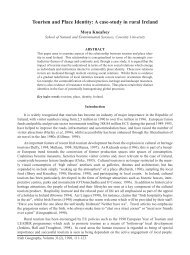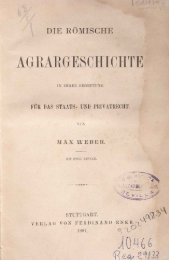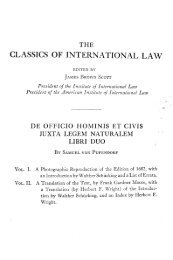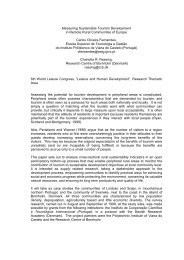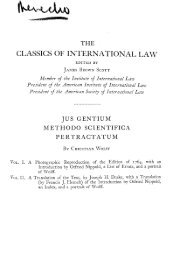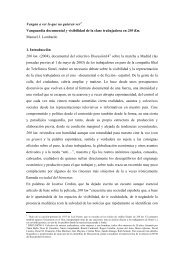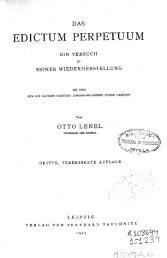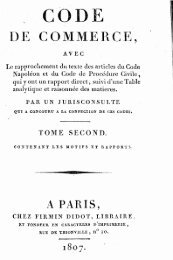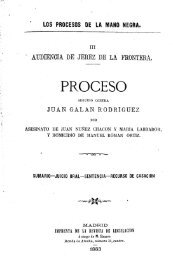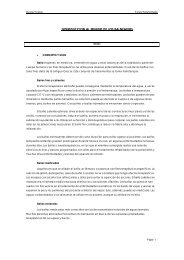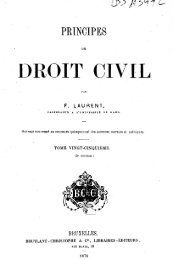Planning for Growth? Re-thinking the Rural Tourism Opportunity1
Planning for Growth? Re-thinking the Rural Tourism Opportunity1
Planning for Growth? Re-thinking the Rural Tourism Opportunity1
You also want an ePaper? Increase the reach of your titles
YUMPU automatically turns print PDFs into web optimized ePapers that Google loves.
Mair/Canadian Society of Extension 2001<br />
3<br />
are causing tensions and community conflict. Most of <strong>the</strong><br />
participants in this study suggested that if <strong>the</strong>y could<br />
address <strong>the</strong> substantive issues including traffic, parking,<br />
consistent business hours and <strong>the</strong> nature of <strong>the</strong> tourism<br />
product (i.e., mass tourism or high-end), <strong>the</strong>n <strong>the</strong>y would<br />
have dealt sufficiently with <strong>the</strong> major irritants. <strong>Re</strong>spondents<br />
in each of <strong>the</strong> study communities expressed that <strong>the</strong> creation<br />
of a tourism plan would be a major step toward solving <strong>the</strong>ir<br />
problems. Through our analysis of <strong>the</strong> decision-making<br />
processes in each of <strong>the</strong> communities, however, it became<br />
clear that <strong>the</strong>re was no identifiable and widely trusted process<br />
<strong>for</strong> making <strong>the</strong> decisions necessary to begin to create this<br />
tourism plan.<br />
<strong>Tourism</strong> development in each of <strong>the</strong> study communities has<br />
moved <strong>for</strong>ward incrementally, and in a direction that has<br />
generally been unplanned and unsupported by residents in<br />
any meaningful way. <strong>Tourism</strong> development that occurs at<br />
<strong>the</strong> whim of local businesses has <strong>the</strong> potential to sow <strong>the</strong><br />
seeds of its own destruction (Mitchell, 1998). Tensions will<br />
develop within <strong>the</strong> community as some members benefit<br />
from tourism and o<strong>the</strong>rs are left out; poorly planned traffic<br />
routes will exacerbate congestion and frustration; <strong>the</strong>re will<br />
be a drop in <strong>the</strong> provision of local services (or an increase in<br />
<strong>the</strong>ir cost); and <strong>the</strong> invasiveness that unchecked tourism<br />
growth can bring to a small community will be increasingly<br />
resented. These community tensions can begin to affect<br />
<strong>the</strong> health (and appeal) of <strong>the</strong> community.<br />
<strong>Re</strong>gardless of whe<strong>the</strong>r respondents saw tourism development<br />
as good <strong>for</strong> <strong>the</strong> community, a necessary evil, or an approach<br />
to development that must be avoided, nearly all respondents<br />
suggested that planning <strong>for</strong> tourism development was an<br />
essential and often neglected activity. <strong>Re</strong>sponses indicated<br />
that undertaking a planning or visioning exercise was<br />
believed to be necessary <strong>for</strong> addressing tourism<br />
development problems and may bridge <strong>the</strong> divides between<br />
those who were in support of unfettered tourism<br />
development, those who accepted limited development and<br />
those who wanted none. Even business owners and those<br />
who stood to gain most directly from intense tourism<br />
development suggested that <strong>the</strong>re should be controls or<br />
guidelines put in place both to ensure consistency and quality<br />
in <strong>the</strong> development of tourism, but also to prevent overdevelopment<br />
which could taint <strong>the</strong> community’s appeal.<br />
Indeed, when asked about potential mechanisms <strong>for</strong><br />
addressing concerns, conflicts and considerations of future<br />
directions, respondents overwhelmingly suggested <strong>the</strong> need<br />
to create a plan. Not working from a community-based<br />
approach, however, can lead to dissatisfied residents whose<br />
attitudes will affect <strong>the</strong> image and tone of community life<br />
and thus risk reducing <strong>the</strong> appeal of <strong>the</strong> area. It is clear that<br />
what is needed in <strong>the</strong> first instance is a process which will<br />
allow <strong>the</strong> various groups in <strong>the</strong> community to confront<br />
collectively <strong>the</strong> irritants which arise as a result of tourism<br />
development. The next section introduces on-going research<br />
in three o<strong>the</strong>r rural communities which is attempting to<br />
develop such a process.<br />
III. Alternative Approaches to <strong>Rural</strong> <strong>Tourism</strong> <strong>Planning</strong><br />
Given <strong>the</strong> issues uncovered in <strong>the</strong> first stage of <strong>the</strong> research,<br />
many questions arise both <strong>for</strong> planners and researchers of<br />
rural tourism. If <strong>the</strong> community is an integral part of <strong>the</strong><br />
tourism product, how might planners create a more integrative<br />
and holistic approach to tourism planning? Some researchers<br />
might consider this to be <strong>the</strong> foundation <strong>for</strong> sustainable<br />
tourism (Hunter, 1997; see also Bramwell and<br />
Sharman 1999). Can <strong>the</strong>re be sustainable rural tourism? How<br />
can it be planned <strong>for</strong>, monitored and controlled? An especially<br />
useful approach to answering <strong>the</strong>se questions is influenced<br />
by <strong>the</strong> work of Hunter (1997). He argues that sustainable<br />
tourism is most effectively used as an “adaptive paradigm”<br />
insofar as it can take different <strong>for</strong>ms in different places,<br />
depending on how one arrives at a balance between <strong>the</strong><br />
perceived needs of <strong>the</strong> community in question, and <strong>the</strong> demands<br />
of <strong>the</strong> tourists visiting <strong>the</strong>m. Hunter sees sustainable<br />
tourism as a continuum (1997: 859-863) wherein a community<br />
could have a ‘tourism imperative’ in that <strong>the</strong>y would<br />
decide which resources would need to be sacrificed in order<br />
to generate income. The o<strong>the</strong>r end of <strong>the</strong> continuum,<br />
‘neotenuous tourism’ or an ecology first perspective, would<br />
actively discourage tourism in an ef<strong>for</strong>t to protect those natural<br />
areas that <strong>the</strong> community wants to protect. This<br />
neotenuous position could be extended beyond ecology<br />
concerns to include <strong>the</strong> preservation of rural community life<br />
and culture.<br />
It is important to note that each step along this continuum<br />
involves a degree of control and preservation, but <strong>the</strong> mix is<br />
decided by <strong>the</strong> community in question and may change over<br />
time. A community that decides to attract an initially large<br />
number of tourists to generate income, <strong>for</strong> instance, may<br />
move along <strong>the</strong> continuum provided that controls (as<br />
determined by <strong>the</strong> community) are in place to safeguard total<br />
destruction until <strong>the</strong>re could be an increased level of<br />
protection or control. Changes in <strong>the</strong> nature of tourism indicate<br />
that tourists may well be accepting of <strong>the</strong> need <strong>for</strong> <strong>the</strong>se<br />
protective measures, and may be willing to take an active<br />
role in encouraging <strong>the</strong>se measures (Hunter, 1997; Aramberri,<br />
2001).<br />
The question remains, of course, of how this might take place.<br />
On-going research with members of three different rural communities<br />
in Southwestern Ontario suggests that an essential<br />
starting point is <strong>the</strong> creation of a community visioning session<br />
which helps to build <strong>the</strong> trust between community members<br />
as all take an equal role in dreaming about <strong>the</strong> future of<br />
<strong>the</strong>ir community. Importantly, <strong>the</strong> focus of this session is<br />
deliberately not on tourism per se but on <strong>the</strong> community<br />
itself. Participants follow <strong>the</strong> model of a search conference,<br />
as set out by Emery and Purser (1996) and spend time drawing<br />
images of <strong>the</strong>ir community, discussing <strong>the</strong>ir drawings<br />
and <strong>the</strong>n making collective decisions about what in <strong>the</strong>ir<br />
Issues in <strong>Rural</strong> Extension


